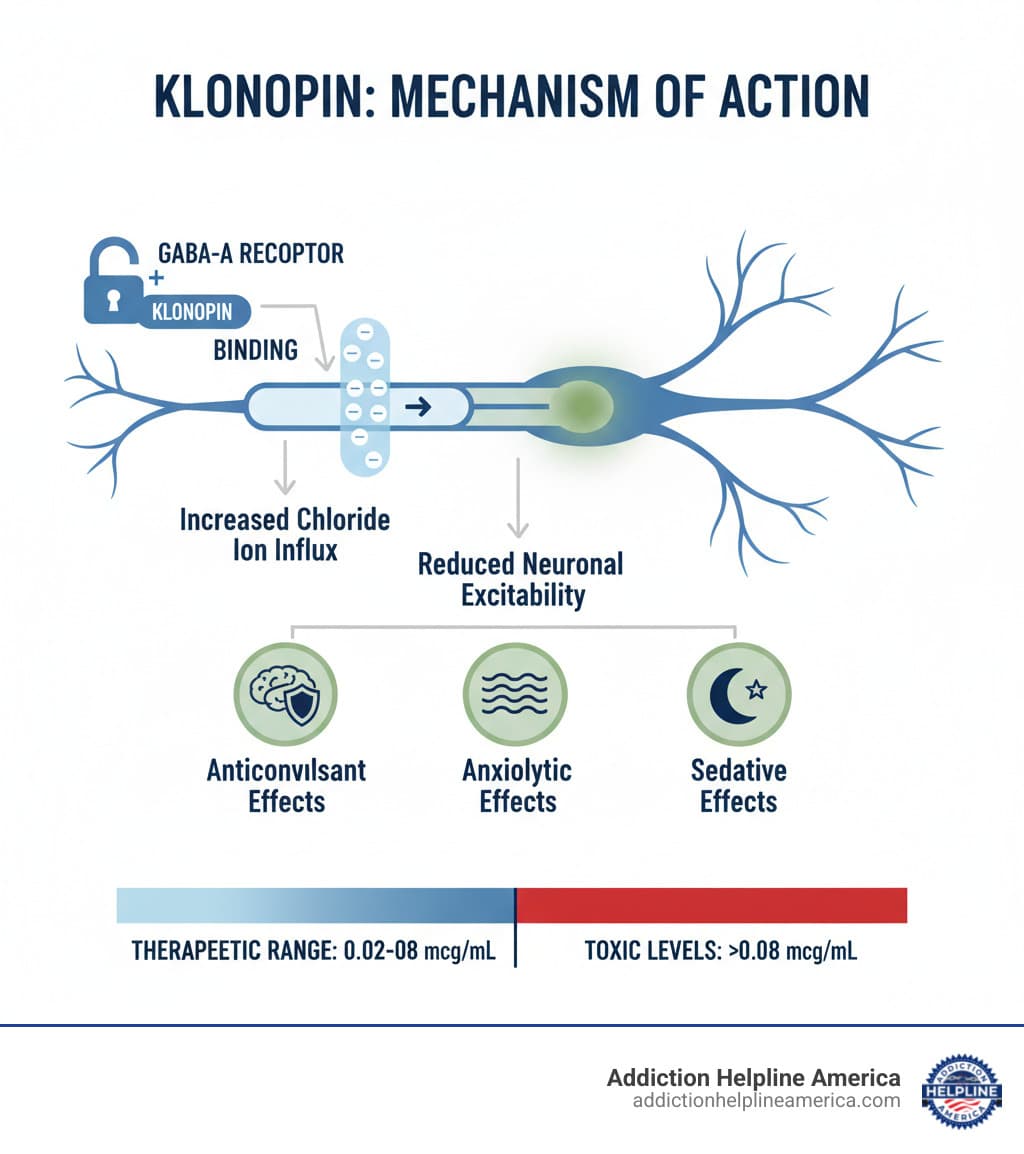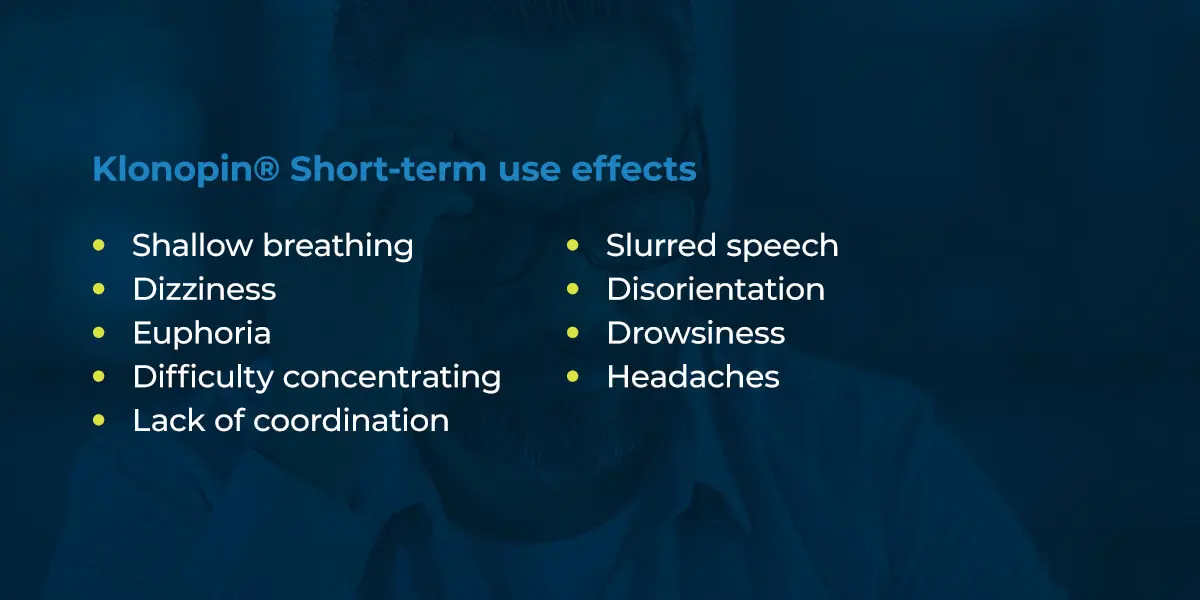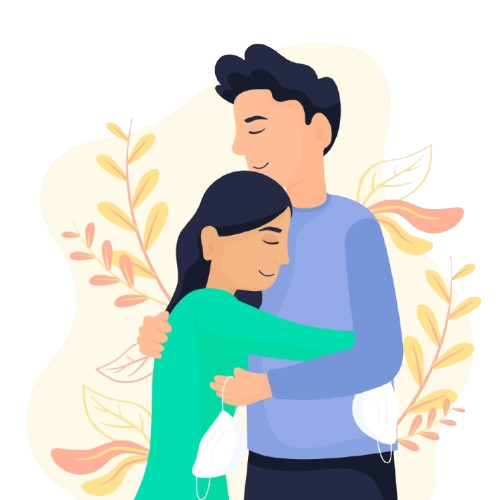Your Journey to a Healthier Life Starts Here
Free Insurance Verification
Verify Your Treatment Coverage
Verify Your Treatment Coverage
Klonopin Treatment refers to the use of clonazepam, a potent benzodiazepine, to manage seizure disorders and panic disorder. While highly effective, Klonopin carries significant risks, including physical dependence, addiction, and dangerous withdrawal symptoms if stopped abruptly.
Key Facts About Klonopin Treatment:
If you or a loved one is struggling with Klonopin dependence, you are not alone. The U.S. Food and Drug Administration warns that Klonopin is habit-forming. The path from legitimate medical use to dependence can happen quickly, sometimes within weeks, because Klonopin is a long-acting, high-potency benzodiazepine that changes brain function.
Physical dependence can develop even when taking the medication as prescribed. When this occurs, stopping suddenly can be life-threatening. At Addiction Helpline America, we guide individuals through the complexities of Klonopin Treatment, connecting them with evidence-based medical detox and rehabilitation services. Our 24/7 helpline provides immediate, confidential support, because we know reaching out is the most important step.

Klonopin is the brand name for clonazepam, a medication from the benzodiazepine class known for its ability to calm the central nervous system. It is both long-acting and high-potency, meaning it stays in your system longer and is effective at lower doses than many other benzodiazepines. These traits make it effective but also contribute to its potential for dependence.
At a molecular level, clonazepam is a GABA-A receptor agonist. It improves the effects of GABA (gamma-aminobutyric acid), the brain’s primary calming neurotransmitter. By amplifying GABA’s natural effects, Klonopin reduces anxiety, prevents seizures, and relaxes muscles. You can explore scientific research on GABA(A) receptors to learn more about the neuroscience.
The FDA has approved Klonopin Treatment for two main categories:
Doctors may also prescribe Klonopin “off-label” for conditions like restless legs syndrome, akathisia (inner restlessness), acute mania, or severe insomnia. However, the risk-benefit profile must be carefully considered for any off-label use, which is why close collaboration with a healthcare provider is essential.
Your brain uses GABA, an inhibitory neurotransmitter, to tell nerve cells (neurons) to slow down and fire less often. Klonopin acts as an amplifier for GABA. It binds to GABA-A receptors, making them more responsive to GABA’s calming signal.
This process increases the flow of chloride ions into neurons, which reduces neuronal excitability. This widespread calming effect across the brain produces Klonopin’s key properties:
This powerful effect is what makes Klonopin valuable for severe seizures and panic attacks, but it’s also why Klonopin Treatment requires careful medical supervision as the brain adapts to these changes over time, leading to physical dependence.
While Klonopin Treatment can be life-changing, it’s crucial to understand its risks. The FDA has issued its strongest safety alert—a boxed warning—for Klonopin regarding the serious risks of abuse, addiction, and physical dependence. These risks are dangerously amplified when combined with opioids.
Most side effects stem from Klonopin’s role as a central nervous system depressant. Drowsiness and sedation are the most common, affecting up to half of users. Many also experience dizziness and impaired coordination (ataxia), which increases the risk of falls, especially in older adults. Persistent fatigue and memory problems can also interfere with daily life.

Depression and an increased risk of suicidal thoughts or behavior are also serious concerns. If you notice mood changes or thoughts of self-harm, contact your doctor immediately. In rare cases, Klonopin can cause paradoxical reactions like agitation, aggression, or irritability. For more information, you can read about benzodiazepine side effects.
Klonopin interacts dangerously with many substances. The most critical interaction is with opioids, alcohol, and other CNS depressants. Combining these can lead to profound sedation, respiratory depression (slowed or stopped breathing), coma, and death.
| Interacting Substance | What Happens |
|---|---|
| Opioids, alcohol, sedatives | Profound sedation, respiratory depression, coma, death |
| Antihistamines | Excessive drowsiness and sedation |
| CYP3A4 inhibitors (antifungals, antibiotics) | Dangerous buildup of Klonopin in your system |
| CYP3A4 inducers (St. John’s Wort) | Reduced Klonopin effectiveness |
| Other antiepileptic drugs | Altered blood levels of both medications |
| Kratom | Increased CNS depression, potential death |

Take the first step towards a healthier life! Call now to connect with our compassionate team and start your recovery journey today. Your path to healing awaits!
Our recovery specialists are available 24/7 to provide support, and all calls are confidential and free. Reach out anytime – we’re here to help!
Certain populations must take special precautions:
Because Klonopin impairs judgment and motor skills, do not drive or operate machinery until you know how it affects you. Always provide your doctor with a complete list of all medications, supplements, and health conditions to ensure a safe treatment plan.
It’s crucial to understand the risks of dependence and addiction associated with Klonopin Treatment. The FDA warns that the medication can be habit-forming.
It’s important to distinguish between physical dependence and addiction. Physical dependence occurs when your body adapts to the drug and experiences withdrawal symptoms if you stop suddenly. This can happen even when taking Klonopin exactly as prescribed. Addiction is a brain disease characterized by compulsive drug-seeking despite harmful consequences.
Signs of Klonopin misuse include taking higher doses than prescribed, “doctor shopping” for more prescriptions, unsuccessfully trying to cut back, and continuing use despite negative impacts on your life, work, or relationships. Combining Klonopin with other substances like alcohol or opioids is another major red flag. The risk is severe; in 2019, about 16% of opioid overdose deaths also involved benzodiazepines.
Stopping Klonopin suddenly is extremely dangerous and can be fatal. Because it is a long-acting benzodiazepine, withdrawal symptoms may not appear for 1-3 days. The process is often broken into phases:
Your withdrawal experience depends on your dosage, duration of use, and overall health. You can learn more about withdrawal timelines here.
Due to the severe risks, medical detox is essential for safely discontinuing Klonopin. Attempting to quit “cold turkey” can lead to seizures and other life-threatening complications.
In a medical detox facility, a team provides 24/7 monitoring and care. The core of safe withdrawal is a tapering schedule, where the dosage is slowly reduced over time. This allows your brain to gradually readjust, minimizing withdrawal symptoms. Doctors may also prescribe other medications to manage specific symptoms like anxiety or to prevent seizures. This supervised process ensures the physical aspects of withdrawal are managed safely, setting the stage for further recovery. Find more information on medical detox programs.
Detox is only the first step. Lasting recovery from Klonopin addiction requires therapy to address the underlying causes of misuse.
These therapies provide the tools needed for a successful, long-term recovery. Learn more about types of addiction therapy.
When considering Klonopin Treatment, it’s important to know that alternatives exist. For many, safer, less habit-forming options can be just as effective for managing anxiety and seizures long-term.
For panic disorder and anxiety, non-medication approaches are highly effective. Cognitive-Behavioral Therapy (CBT) teaches lifelong skills to manage anxiety without drugs. Mindfulness, meditation, and regular exercise are also proven to reduce anxiety and improve mood. When medication is needed, doctors often prefer SSRIs (Selective Serotonin Reuptake Inhibitors) or other antidepressants that treat anxiety without the high dependence risk of benzodiazepines.
For seizure disorders, a wide range of alternative anticonvulsant medications is available. For difficult-to-treat epilepsy, options like Vagus Nerve Stimulation (VNS) or the ketogenic diet may be considered. An open conversation with your healthcare provider is key to finding the best approach for you.
The best Klonopin Treatment involves a team of healthcare professionals working together. This collaborative model ensures safety and comprehensive care.
This team approach is supported by tools like Prescription Drug Monitoring Programs (PDMP) to prevent misuse. For those with a dual diagnosis (both a substance use disorder and a mental health condition), this integrated care model is essential for treating the whole person, not just the symptoms.

This holistic support system leads to the best possible outcomes, whether you are managing Klonopin safely or navigating the path to recovery. At Addiction Helpline America, we connect you with programs that accept this team-based approach.
Here are answers to some of the most common questions about Klonopin.
Klonopin works relatively quickly. You will typically feel its calming effects within 30 to 60 minutes. The medication reaches its peak strength in your bloodstream within 1 to 4 hours.
As a long-acting benzodiazepine, its effects last for 8 to 12 hours in adults. Your individual metabolism and dosage can influence this timing.
Yes, a Klonopin overdose can be life-threatening. While an overdose on Klonopin alone can cause extreme drowsiness and confusion, the risk becomes fatal when it is combined with other central nervous system depressants like opioids or alcohol.
This combination can cause your breathing to slow down or stop completely. Warning signs of an overdose include:
If you suspect an overdose, call 911 immediately. You can also contact the poison control helpline at 1-800-222-1222 or visit www.poisonhelp.org/help. Be honest with your doctor about all substances you use, including alcohol, to prevent a dangerous interaction.
Generally, no. Klonopin is not intended for long-term use. Its effectiveness for panic disorder beyond 9 weeks is largely unknown, and tolerance can develop over time for seizure control.
The FDA warns about the risks of long-term use, which include:
If you are on long-term Klonopin Treatment, your doctor should regularly reevaluate if it is still the best option and discuss potential alternatives.
We’ve covered how Klonopin Treatment works, from its benefits for seizures and panic to the serious risks of dependence, addiction, and withdrawal. Klonopin can provide relief, but it demands respect and careful medical oversight. The line between therapeutic use and dependence can blur quickly.
Whether you are seeking to understand your prescription better or are worried about yourself or a loved one, know this: you are not alone, and help is available.
It takes courage to admit you need support. It takes strength to reach out. And it takes hope to believe recovery is possible—and it absolutely is.
At Addiction Helpline America, we have guided countless individuals and families through these challenges. We believe in personalized, compassionate care that meets you where you are. We connect people nationwide with a network of vetted addiction and mental health treatment centers.
Our admissions navigators are available 24/7 to help you find the right program, whether you need:
The call is free, confidential, and there is no judgment. You don’t need a plan; you just need to take the first step.
Stopping Klonopin without medical help is too dangerous to risk. With professional guidance, recovery is not just possible—it’s happening every day. If you or someone you love is struggling, please don’t wait.
Are you or a loved one struggling with addiction? Call today to speak to a treatment expert.
Calls to any general helpline will be answered or returned by one of the treatment providers listed, each of which is a paid advertiser:
Our helpline is available 24 hours a day, 7 days a week at no cost to you and with no obligation for you to enter into treatment. We are committed to providing support and guidance whenever you need it.
In some cases, Addiction Helpline America charges our verified partner a modest cost per call. This fee helps us cover the costs of building and maintaining our website, ensuring that we can continue to offer this valuable service to those in need.
Calls to the general helpline will be answered or returned by one of the listed treatment providers, all of whom are paid advertisers.
By using the helpline, you agree to the terms of use. We do not earn any commission or fee based on the treatment provider selected by the caller, and there is no obligation to pursue treatment.
This service is not affiliated with Alcoholics Anonymous World Services, Inc.